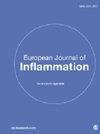前体信使 RNA 作为肌无力胸腺瘤潜在生物标志物的硅学分析
IF 0.8
4区 医学
引用次数: 0
摘要
手稿对胸腺瘤中潜在的重症肌无力(MG)前mRNA生物标志物进行了硅学分析。GSE11967数据集和Gene Expression Omnibus数据库中的platform5188用于数据预处理、归一化和质量控制。质量指标表明整体数据完整性很高,没有发现明显的异常值或批次效应。我们将胸腺瘤样本与正常胸腺组织进行比较,以确定 DEGs。功能富集和通路分析、本体分析和 KEGG 通路分析进一步研究了潜在的潜在生物学过程。尽管基因表达谱分析被广泛用于鉴定潜在的生物标记物和治疗靶点,但本研究利用 GSE11967 数据集鉴定了 MG 胸腺瘤与正常胸腺组织相比的 DEGs ENSG00000112345 和 ENSG00000234567 以及通路,如 hsa04110、hsa03013 和 hsa04115。GSE11967 数据集显示,与健康组织相比,胸腺肿瘤相关的 MG 组织中存在重要的 DEG 和通路。需要采用更广泛的综合方法来了解 MG 患者胸腺瘤中复杂的表达生物标志物,以及通过多组学方法了解可能导致疾病的其他调控机制。本文章由计算机程序翻译,如有差异,请以英文原文为准。
In silico analysis of precursor messenger RNA as a potential biomarker of myasthenia gravis thymoma
The manuscript analyzes potential pre-mRNA biomarkers of Myasthenia gravis (MG) in thymoma in silico. GSE11967 data set and platform5188 from the Gene Expression Omnibus database apply for data preprocessing, normalization, and quality control. Quality metrics indicated high overall data integrity, with no significant outliers or batch effects detected. Differential expression analysis (DEG.) uses the limma package in R. We compared thymoma samples to normal thymus tissue to identify DEGs. The significance criteria are adjusted p-value <0.05 and a |log2 fold change| > 1. Functional enrichment and pathway analysis, ontology analysis, and KEGG pathway analysis further investigate the potential underlying biological processes. Despite the extensive use of gene expression profiling for identifying potential biomarkers and therapeutic targets, this study identifies DEGs ENSG00000112345 and ENSG00000234567 and pathways like hsa04110, hsa03013 and hsa04115 in thymoma with MG compared to normal thymus tissue using the GSE11967 dataset Plots like UMAP, Boxplot, Expression density and Mean variance demonstrate differential expression in disease and control group. The GSE11967 data set shows the presence of significant DEG and pathways in thymoma-associated MG tissue, compared to healthy tissue. A broader and integrative approach is needed to understand the complex expression biomarkers in thymoma in MG patients and other regulatory mechanisms that may contribute to the disease by multi-omic approaches.
求助全文
通过发布文献求助,成功后即可免费获取论文全文。
去求助
来源期刊

European Journal of Inflammation
Medicine-Immunology and Allergy
自引率
0.00%
发文量
54
期刊介绍:
European Journal of Inflammation is a multidisciplinary, peer-reviewed, open access journal covering a wide range of topics in inflammation, including immunology, pathology, pharmacology and related general experimental and clinical research.
 求助内容:
求助内容: 应助结果提醒方式:
应助结果提醒方式:


